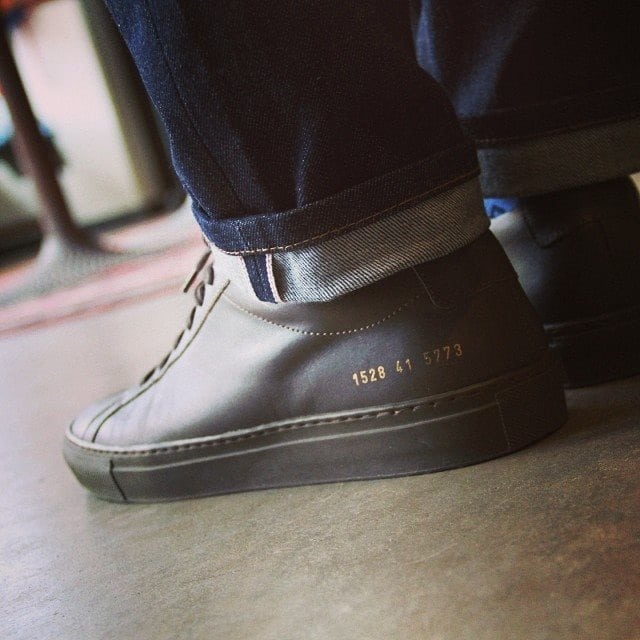Is raw denim the same as selvedge denim?
Is Raw denim the same as Selvedge denim?
That’s the driving question behind my ongoing search for the perfect pair of jeans this fall. You see, I’ve had the same pair of jeans for maybe 3 or 4 years now. Late in the winter they sprung a leak, in the form of a large hole over the knee. I’ll still wear them from time to time, but the occasion has changed and now I need to find a new pair for dressier outings (when one of my suits is too much, of course!)
Simply put, I want something special and something that will last me a long time.
I’ve heard the buzzwords. I think we all have. Raw denim, selvedge denim, self-edge, etc. But what do they mean?
And from an economics perspective, where should I consider investing my money? So, I did some research. This fall I’m going to keep you in the loop on my search for the perfect pair of jeans. I think we’re both going to learn a lot.
To start off the series, I wanted to investigate the difference between raw denim and selvedge denim.
Raw denim
Raw denim is just what the name says: it’s raw. That means it hasn’t been processed in any way, such as washing or strategic distressing. You can think of it as coming straight off the loom to the shelf in the store.
But let’s back up a moment.
What makes your jeans blue in the first place? Where does that “jean color” hue come from? Well, it’s indigo dye. And here’s what is unique about indigo dye – it doesn’t absorb into the fabric. Instead, it merely coats the fibers. Consequently, over time it can rub off. This is how your jeans become faded in all the right places. Your unique lifestyle and wearing habits, over time, will have a direct impact on how your jeans look. They will become entirely individual to you.
Now what you need to bear in mind is that raw denim will shrink. There is a notable exception – sanforized denim. This is still considered raw denim – although some true believers may disagree with me on this one – but the shrinking will be very, very minimal.
The other thing to be aware of is that raw denims will also be a little stiff to wear in the beginning. They demand a break-in period. And honestly, this is what has kept me away from raw denim for so long. Shopping for jeans in the store I would also seek out the softest pair. While this meant they were comfortable from the beginning, their longevity was impacted.
Selvedge denim
First of all, you may see different spelling of this word – self-edge or selvage, maybe. But it’s all the same thing. The spelling selvedge is a bit more traditional and appropriate, so it’s what I’ll continue to use here.
Selvedge actually means “self edge.” This is because instead of having frayed edges, like most garments, selvedge denim is finished by looping the weft threads (the yarns that run from side to side) back at the end of each row on a shuttle loom. A shuttle loom uses one continuous piece of yarn to run back and forth across the warp threads that run up and down. There are no frayed edges this way. Everything is kept nice and neat from a manufacturing perspective.
Up until about the 1950s, almost all denim was produced this way.
What changed?
Well, as you can imagine, the demand for more productivity and higher efficiency led to the so-called mass production looms that churned out several times the output of a humble shuttle loom…and they did so without the closed edges.
This method requires the edges to be “overlocked stitched” to keep the frayed yarns in place.
From my research, there is only one domestic selvedge denim producer in existence today, Cone Mills in Greensboro, North Carolina. Interestingly, the rest are in Japan. Beginning in the 1980s, a handful of Japanese mills began weaving their own selvedge denim and even recasting rivets and buttons in an attempt to recapture the vintage American style.
I reached out to Denver based Armitage & McMillan co-owner, Daniel Armitage, for some good photos of selvedge jeans from his store. The following two images highlight the defining feature that makes selvedge denim unique – the accent stitching on the outseam (in this case, red).


In theory, selvedge jeans will last longer than a raw or washed jean due to this sealed edge. But I think it’s really how you wear the jeans. After all, my present pair – that wasn’t raw nor selvedge denim – failed me via a hole on the knee, not the unraveling of the outseam.
Wrap up
So, is raw denim the same as selvedge denim?
In summation, selvedge denim can be raw, but raw denim is not always selvedge denim.
Here’s all you need to remember: Selvedge denim has to do with the weaving process, it has a “self edge.” Whereas raw denim just means that it hasn’t been washed and processed after coming off of the loom.
Yet both will likely end up being more durable than a distressed or typical off-the-rack garment.
Regardless, I think the real charm of denim today is that we have an opportunity to seek out traditional manufacturing methods that emphasize durability and can provide you with an opportunity to wear a pair of jeans that you can truly make your own.
Further reading
Here’s what you should know about raw denim before buying a pair, from Washington Alley.
And another great article from Heddels: The essential raw denim breakdown.
Or, if you’d prefer a video, here’s one on the Cone Mill from the folks at Self Edge: https://vimeo.com/38817626
Check out some jeans in person at Armitage & McMillan in Denver: 1550 Platte St, Denver, CO





